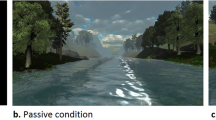Abstract
In brain-computer interface applications such as neurofeedback (NF), traditional 2D visual feedback has been replaced frequently by more sophisticated 3D virtual reality (VR) scenarios. VR is considered to be more motivating and to increase NF training success. However, hard evidence on user experience in set-ups combining VR-EEG NF has been scarcely reported. Hence, we evaluated user experience on cybersickness, discomfort/pain, technology acceptance and motivational factors and compared them between a 3D and a 2D VR scenario. Additionally, we focused on possible sex differences. 68 subjects received one VR-neurofeedback session with either a 3D or 2D VR paradigm. Statistical analyses showed that sickness was higher after the VR-NF training than before, and women experienced higher sickness values than men. Further, women reported more subjective pressure sensations on the head, eye burning and headache, as well as higher technology anxiety, less perceived usefulness of the used technology and less perceived technology accessibility. No dimensionality or sex differences regarding subjective feeling of flow and presence were found. Moreover, no differences between the 3D and 2D VR scenarios were observed. Our results indicate sex differences in user experience in VR-based NF paradigms, which should be considered when using VR as feedback modality in future NF applications. In contrast, 3D or 2D presentation of the VR scenario did not affect user experience, indicating that more immersive 3D VR scenarios do not cause more negative side effects than the less immersive 2D VR scenario.
Access this chapter
Tax calculation will be finalised at checkout
Purchases are for personal use only
Similar content being viewed by others
References
Pesudovs, K.: The development of a symptom questionnaire for assessing virtual reality viewing using a head-mounted display. Optom. Vision Sci. 82(7), 571 (2005). https://doi.org/10.1097/01.opx.0000171186.02468.b7
Brooks, J.O., et al.: Simulator sickness during driving simulation studies. Accid. Anal. Prev. 42(3), 788–796 (2010). https://doi.org/10.1016/j.aap.2009.04.013
Cai, Z., Fan, X., Du, J.: Gender and attitudes toward technology use: a meta-analysis. Comput. Educ. 105, 1–13 (2017). https://doi.org/10.1016/j.compedu.2016.11.003
Davis, S., Nesbitt, K., Nalivaiko, E.: A systematic review of cybersickness. In: Blackmore, K., Nesbitt, K., Smith, S.P. (eds.) Proceedings of the 2014 Conference on Interactive Entertainment, pp. 1–9. ACM, New York, NY, USA (2014)
Davis, F.D., Bagozzi, R.P., Warshaw, P.R.: User acceptance of computer technology: a comparison of two theoretical models. Manage. Sci. 35, 982–1003 (1989)
Gruzelier, J., Inoue, A., Smart, R., Steed, A., Steffert, T.: Acting performance and flow state enhanced with sensory-motor rhythm neurofeedback comparing ecologically valid immersive VR and training screen scenarios. Neurosci. Lett. 480(2), 112–116 (2010). https://doi.org/10.1016/j.neulet.2010.06.019
Juliano, J., et al.: Embodiment is related to better performance on a brain–computer interface in immersive virtual reality: a pilot study. Sensors 20(4), 1204 (2020). https://doi.org/10.3390/s20041204
Kennedy, R.S., Lane, N.E., Berbaum, K.S., Lilienthal, M.G.: Simulator sickness questionnaire: an enhanced method for quantifying simulator sickness. Int. J. Aviat. Psychol. 3(3), 203–220 (1993). https://doi.org/10.1207/s15327108ijap0303_3
Kleih, S.C., Nijboer, F., Halder, S., Kübler, A.: Motivation modulates the P300 amplitude during brain-computer interface use. Clin. Neurophysiol. 121(7), 1023–1031 (2010). https://doi.org/10.1016/j.clinph.2010.01.034
Kober, S.E., Kurzmann, J., Neuper, C.: Cortical correlate of spatial presence in 2D and 3D interactive virtual reality: an EEG study. Int. J. Psychophysiol. 83(3), 365–374 (2012). https://doi.org/10.1016/j.ijpsycho.2011.12.003
Kober, S.E., Reichert, J.L., Schweiger, D., Neuper, C., Wood, G.: Effects of a 3D Virtual Reality Neurofeedback Scenario on User Experience and Performance in Stroke Patients. In: Bottino, R., Jeuring, J., Veltkamp, R.C. (eds.) GALA 2016. LNCS, vol. 10056, pp. 83–94. Springer, Cham (2016). https://doi.org/10.1007/978-3-319-50182-6_8
Kober, S.E., Reichert, J.L., Schweiger, D., Neuper, C., Wood, G.: Does feedback design matter? A neurofeedback study comparing immersive virtual reality and traditional training screens in elderly. IJSG 4(3) (2017). doi:https://doi.org/10.17083/ijsg.v4i3.167
Kolasinski, E.M.: Simulator Sickness in Virtual Environments, Bd 1995. Alexandria, VA (1995)
Kothgassner, O.D., Felnhofer, A., Hauk, N., Kastenhofer, E., Gomm, J., Kryspin-Exner, I.: TUI – Technology Usage Inventory. Manual (2013)
Marzbani, H., Marateb, H.R., Mansourian, M.: Neurofeedback: a comprehensive review on system design, methodology and clinical applications. Basic Clin. Neurosci. 7(2), 143–158 (2016). https://doi.org/10.15412/J.BCN.03070208
Oh, S.Y., Bailenson, J.: Virtual and augmented reality. In: Rössler, P., Hoffner, C.A., van Zoonen, L. (eds.) The International Encyclopedia of Media Effects, pp. 1–16. John Wiley & Sons Inc, Chichester, West Sussex, Malden, MA (2017)
de Barros, P., França, F.: Follow-up to case study: neurofeedback as a first choice treatment in an adhd and comorbidities. KLS (2018). https://doi.org/10.18502/kls.v4i8.3285
Paillard, A.C., et al.: Motion sickness susceptibility in healthy subjects and vestibular patients: effects of gender, age and trait-anxiety. J. Vestibular Res. 23(4–5), 203–209 (2013). https://doi.org/10.3233/VES-130501
Regenbrecht, H.T., Schubert, T.W., Friedmann, F.: Measuring the sense of presence and its relations to fear of heights in virtual environments. Int. J. Hum. Comput. Interact. 10(3), 233–249 (1998). https://doi.org/10.1207/s15327590ijhc1003_2
Rheinberg, F., Vollmeyer, R., Engeser, S.: FKS – Flow-Kurzskala. ZPID (Leibniz Institute for Psychology Information) – Testarchiv (2019)
Rheinberg, F., Vollmeyer, R., Burns, B.D.: FAM – Fragebogen zur aktuellen Motivation. ZPID (Leibniz Institute for Psychology) – Open Test Archive (2021)
Salisbury, D.B., Dahdah, M., Driver, S., Parsons, T.D., Richter, K.M.: Virtual reality and brain computer interface in neurorehabilitation. Baylor Univ. Med. Center Proc. 29(2), 124–127 (2016)
Schabus, M., et al.: Enhancing sleep quality and memory in insomnia using instrumental sensorimotor rhythm conditioning. Biol. Psychol. 95, 126–134 (2014). https://doi.org/10.1016/j.biopsycho.2013.02.020
Schmidt, M., Kafka, J.X., Kothgassner, O.D., Hlavacs, H., Beutl, L., Felnhofer, A.: Why does it always rain on me? Influence of gender and environmental factors on usability, technology related anxiety and immersion in virtual environments. In: Reidsma, D., Katayose, H., Nijholt, A. (eds.) ACE 2013. LNCS, vol. 8253, pp. 392–402. Springer, Cham (2013). https://doi.org/10.1007/978-3-319-03161-3_29
Shafer, D., Korpi, M., Carbonara, C.P.: Modern Virtual reality technology: cybersickness, sense of presence, and gender. Media Psychol. Rev. 11, 1–13 (2017)
Sharples, S., Cobb, S., Moody, A., Wilson, J.R.: Virtual reality induced symptoms and effects (VRISE): comparison of head mounted display (HMD), desktop and projection display systems. Displays 29(2), 58–69 (2008). https://doi.org/10.1016/j.displa.2007.09.005
Stanney, K., Fidopiastis, C., Foster, L.: Virtual Reality is sexist: but it does not have to be. Front. Rob. AI 7, 4 (2020). https://doi.org/10.3389/frobt.2020.00004
Tatum, W.O., Dworetzky, B.A., Schomer, D.L.: Artifact and recording concepts in EEG. J. Clin. Neurophysiol. 28(3), 252–263 (2011). https://doi.org/10.1097/WNP.0b013e31821c3c93
Van Doren, J., Arns, M., Heinrich, H., Vollebregt, M.A., Strehl, U., Loo, S.K.: Sustained effects of neurofeedback in ADHD: a systematic review and meta-analysis. Eur. Child Adolesc. Psychiatry 28(3), 293–305 (2018). https://doi.org/10.1007/s00787-018-1121-4
Weech, S., Kenny, S., Barnett-Cowan, M.: Presence and cybersickness in virtual reality are negatively related: a review. Front. Psychol. 10, 158 (2019). https://doi.org/10.3389/fpsyg.2019.00158
Williams, J.M., Thirer, J.: Vertical and horizontal peripheral vision in male and female athletes and nonathletes. Res. Quarterly Am. Alliance Health Phys. Educ. Recreation 46(2), 200–205 (1975). https://doi.org/10.1080/10671315.1975.10615324
Witte, M., Kober, S.E., Ninaus, M., Neuper, C., Wood, G.: Control beliefs can predict the ability to up-regulate sensorimotor rhythm during neurofeedback training. Front. Hum. Neurosci. 7, 478 (2013). https://doi.org/10.3389/fnhum.2013.00478
Xiang, M.-Q., Hou, X.-H., Liao, B.-G., Liao, J.-W., Hu, M.: The effect of neurofeedback training for sport performance in athletes: a meta-analysis. Psychol. Sport Exercise 36, 114–122 (2018). https://doi.org/10.1016/j.psychsport.2018.02.004
Young, S.D., Adelstein, B.D., Ellis, S.R.: Demand characteristics in assessing motion sickness in a virtual environment: or does taking a motion sickness questionnaire make you sick? IEEE Trans. Visualization Comput. Graphics 13(3), 422–428 (2007). https://doi.org/10.1109/TVCG.2007.1029
Author information
Authors and Affiliations
Corresponding author
Editor information
Editors and Affiliations
Rights and permissions
Copyright information
© 2021 Springer Nature Switzerland AG
About this paper
Cite this paper
Berger, L.M., Wood, G., Neuper, C., Kober, S.E. (2021). Sex Differences in User Experience in a VR EEG Neurofeedback Paradigm. In: de Rosa, F., Marfisi Schottman, I., Baalsrud Hauge, J., Bellotti, F., Dondio, P., Romero, M. (eds) Games and Learning Alliance. GALA 2021. Lecture Notes in Computer Science(), vol 13134. Springer, Cham. https://doi.org/10.1007/978-3-030-92182-8_11
Download citation
DOI: https://doi.org/10.1007/978-3-030-92182-8_11
Published:
Publisher Name: Springer, Cham
Print ISBN: 978-3-030-92181-1
Online ISBN: 978-3-030-92182-8
eBook Packages: Computer ScienceComputer Science (R0)




